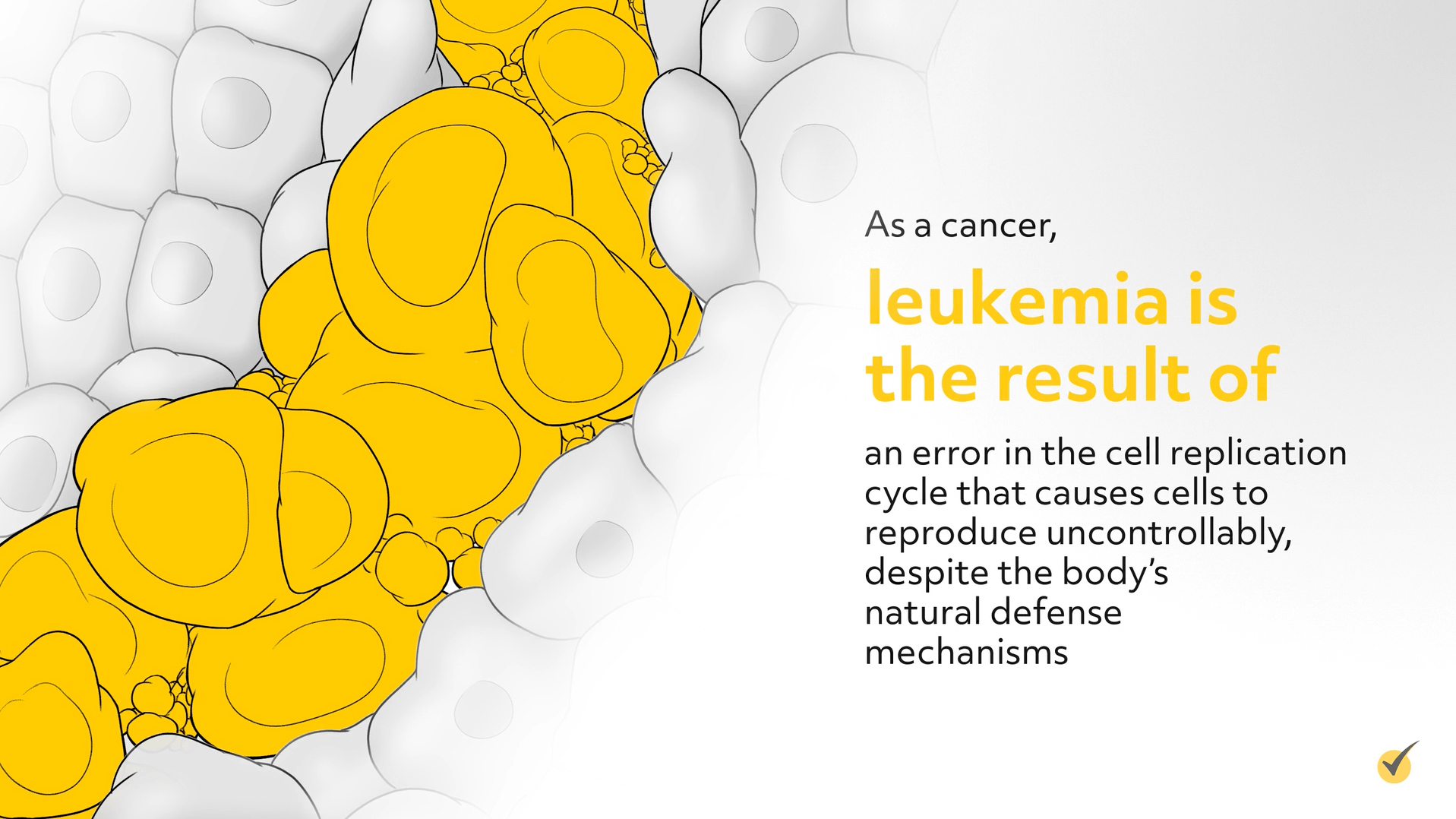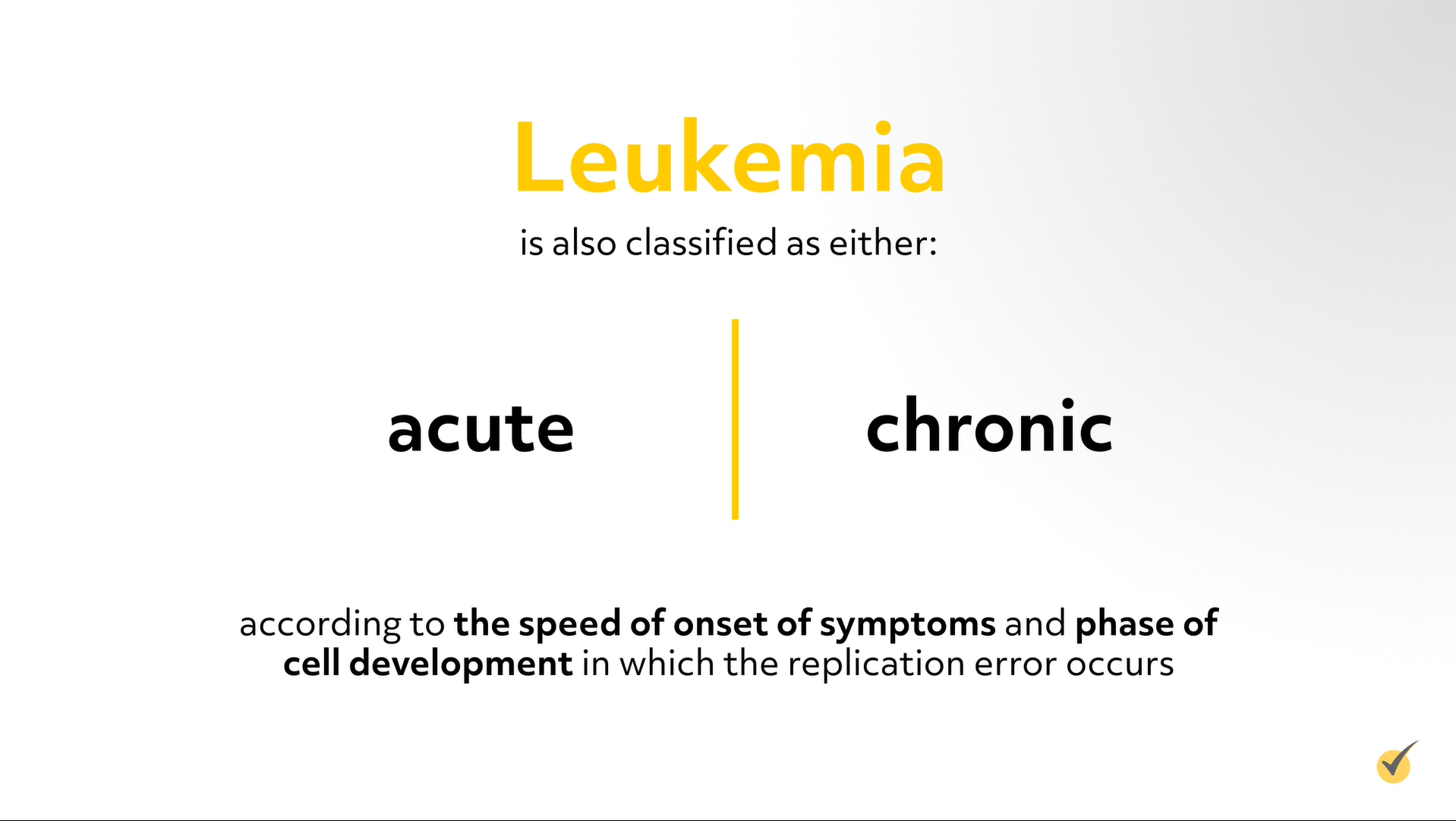Leukemia

Hi, and welcome to this review of leukemia.
Leukemia Origins
Leukemia refers to cancer that originates in blood-forming stem cells, most commonly in the cells that develop into white blood cells. The word “leukemia” comes from the Greek words “leukos” which means white, and “hemia” which means blood.
As a cancer, leukemia is the result of an error in the cell replication cycle that causes cells to reproduce uncontrollably, despite the body’s natural defense mechanisms. Leukemia is generally categorized based on the type of stem cells the cancer starts in. If the cancer starts in myeloid cells—the cells that become WBCs, RBCs, or platelet-making cells—it is known as a myeloid or myelogenous leukemia. If the cancer starts in cells that become lymphocytes, it is known as lymphocytic leukemia.

Classification of Leukemia
Leukemia is also classified as either acute or chronic, according to the speed of onset of symptoms and phase of cell development in which the replication error occurs. The onset of acute leukemia happens relatively suddenly, often over a few weeks, and can lead to death in several weeks or months if left untreated. Leukemic cells in acute leukemia are immature cells called blasts. Chronic leukemia develops more gradually, over months or even years, and also progresses more slowly. Most of the leukocytes produced in patients with chronic leukemia are mature.

Some forms of leukemia do not fit neatly into these classifications, but they are usually considered to be rare.
Leukemia involves the uncontrolled replication of white blood cells, called leukocytes, in the bone marrow. As the site of blood cell production, bone marrow allows cells to enter the circulatory system, and leukemic cells proliferating in the bone marrow can gain access to the rest of the body as well. These cancer cells can continue to proliferate in the liver and spleen, in some cases, and can also infiltrate other organs.
As with other cancers, leukemic cells take up space that would otherwise be occupied by normal cells, and this displacement can interrupt the production of healthy cells. White blood cell counts may be increased or decreased depending on the type of leukemia present, but the number of healthy leukocytes is typically decreased. Neutropenia can increase the risk of infection and fever even before potentially immunosuppressive treatment begins. Anemia, or a decrease in red blood cells, can result in fatigue or weakness. Thrombocytopenia, or a decrease in platelets responsible for blood clotting, can increase the risk for bleeding.
Symptoms and Manifestations
Symptoms of leukemia vary, depending on the type of leukemia. Common signs and symptoms of leukemia include:
- frequent or severe infections
- fever
- persistent fatigue
- weakness
- losing weight without trying
- excessive sweating- especially at night
- easy bruising or bleeding
- swollen lymph nodes
- enlarged liver or spleen
- bone pain or tenderness
Additionally, an accumulation of leukemic cells can cause tenderness or pain. Leukemic cells infiltrating the central nervous system can lead to headaches and vomiting.
Some signs and symptoms are present especially in certain forms of leukemia. Very high leukocyte counts in patients with chronic myeloid leukemia inhibits blood flow and decreases perfusion to the brain and lungs and can result in slight confusion or shortness of breath. Patients with chronic lymphocytic leukemia can develop “B” symptoms (systemic symptoms), which include fever, drenching sweats- especially at night, and unintentional weight loss. Lymph nodes can also enlarge and cause pain.
Treatment Approaches
Treatment for leukemia depends on factors such as its type and any comorbid medical conditions or other considerations, such as the patient’s age. Treatments are typically aimed at destroying cancer cells and stopping the progression of disease, but, for some patient situations, supportive or palliative care alone is also an option. Chemotherapy is the most common medical treatment for leukemia and sometimes involves combinations of several medications with slightly different actions. Some types of leukemia that are caused by chromosomal abnormalities that lead to the production of an abnormal protein can be treated with medications that target the protein specifically. Radiation therapy is sometimes used in conjunction with chemotherapy. Some aggressive treatments attempt to destroy leukemic cells by eliminating all blood-forming stem cells, which are then replaced via a bone marrow transplant.
Nursing management of patients with leukemia can involve administering chemotherapy and other medications according to physician orders and providing supportive care for symptoms and side effects. Chemotherapy is cytotoxic, meaning toxic to cells, and normal cells are affected in addition to the cancer cells being targeted. In addition to the symptoms of the disease, chemotherapy can also have unpleasant side effects. Chemotherapy also further reduces immune function, so infection prevention precautions should be observed, and patients should be monitored for signs of infection. Patients diagnosed with leukemia may also experience emotional distress, anxiety, and grief, especially when life is disrupted suddenly with symptoms and treatments.
Thanks for watching and happy studying!
